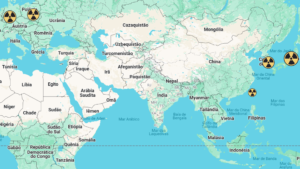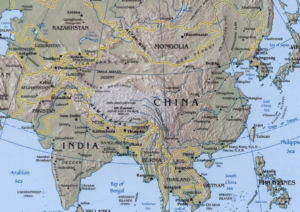The use of technology in military conflicts has been improving every day, and this includes the use of drones.
Drones are unmanned aerial vehicles (UAV) or remotely piloted aircraft (RPA), which do not require pilots on aircraft to control them. They are usually controlled remotely, by electronic means with human supervision, or by programmable route controllers. The military use of drones has several functions, such as reconnaissance of areas or targets, surveillance and attacks.
Since 2015, several nations have invested more in their aerial drone fleet (more than 51 countries use the technology) and many have extremely effective systems that boost the mass use of military UAVs, such as Turkey’s Bayraktar TB2 drone.

The History of Using Drones in Armed Conflict
The first drones were created by the United States and England during World War I, being in 1917 the first test flight of an aircraft with radio control.
Its operation was inspired by the German aerial bombs (called V-1), along with the radio control system, forming an aircraft with no crew required for its command.
They are principally security cameras in the sky and are able to beam high-definition real-time imagery back to the headquarters. Once a target has been identified, it can be destroyed on the spot by the guided munitions carried by the drones.
Aljazeera
The Vietnam War was the first conflict where the use of American drones was present in high numbers, 38 years after its first flight test. The main function of UAVs was to serve as decoy, reconnaissance of the conflict area, launch missiles against fixed targets and release leaflets for psychological operations.
After that, its use was spread on other countries as technologies of recognition, surveillance and military attacks.
Currently, the manufacturing and research of drone systems take place in several countries, some with the support of the United States, as in the case of Israel. However, it is possible to observe that more countries are embarking on technological improvement investments independently, since their combat efficiency is high.
The use of drones around the world in “War on Terror” by the United States
Since the terrorist attack of September 11, the United States has further deepened its already historical use of drones, mainly in its missions in the “War on Terror”, making it one of the main military weapons used by the armed forces.
The mission targeted Muslim extremist groups such as Al-Qaeda, Islamic State and its variations. The affected countries were: Afghanistan, Pakistan, Iraq, Libya, Syria, Yemen, Somalia and the Philippines.
A 2021 study by the Watson Institute for International and Public Affairs estimated that these conflicts caused the deaths of 897,000 to 929,000 people, including more than 364,000 civilians, and cost of US$8 trillion.
There are records that count more than 1100 UAV attacks from the US being about 145 drone attacks against Libya, 48 in Iraq and more than 1000 (in addition to 299 attacks from the UK) in Afghanistan.
The high use of drones by the US is the subject of great criticism about the ethics of conducting these armed conflicts, since UAVs were the cause of civilian deaths in the errors of target attacks.
The use of drones has the advantage of not putting at risk the contingent of soldiers, pilots, and military equipment of high value from the country, because it is a remote device and with some programmed attack functions. However, the accuracy of their target identification systems is still under improvements, and sometimes they cause high damage to the population of the country under attack.
The ethical and moral question here is in relation to the priority that the country on the offensive has with its own military bases and the indifference with the population attacked, when it is seen only as “collateral loss.”
These new technologies require a reformulation of international laws so that issues such as this are not only open to interpretation, especially when the totally autonomous drones are used, which we will talk about down below.
The massification of the use of drones in conflicts: the Turkish Bayraktar TB2
The efficiency and effectiveness that drones provide in armed conflict is what has allowed an advance and investment in the improvement of systems technologies.
The cost that a conflict or wars cause to countries is a factor of consideration in planning it. Drones were formerly a privileged technology because of their production price and the mechanics involved.
Nowadays, the bases of technical knowledge are larger and make it possible a greater evolution of systems, higher distribution and cheaper prices. This is the case of the Bayraktar TB2 UAV from Turkey, which has been changing the world military weapons scene.

Bayraktar TB2 Turco is a long-range medium-altitude drone (MALE) with long distance control with the possibility of autonomous flights guided by the Türksat satellite. It was developed in 2014 after the US ban on UAV exports to Turkey for concern that they would be used in attacks against the Kurdistan Workers’ Party.
It is already used by several countries like Ukraine, Qatar and Azerbaijan and with prospects of more purchases by Poland and Albania.
“Bayraktar TB2 successfully completed 420,000 flight hours and purchase contracts were concluded with 16 countries. In addition, the first export contract for the Bayraktar Akinci combat UAV was signed. The deliveries provided for in the contract are for 2023, “said Haluk Bayraktar.
Sputink News BR
Its sale price is estimated at US$5 million a unit, which in comparison to other drones is much more cheaper, such as Predator from the USA (the most famous drone in history) which costs US$40 million per system or its evolution the Reaper that costs US$32 million.
The price and the proven effectiveness of the conflicts in Eastern Europe and the Middle East provided an easier opportunity to massify the use of drones for several countries. It was on 2015 that many nations acquired a UAV air force.
The Turkish drone Bayraktar TB2 winning wars
Several countries are signing contracts to purchase Bayraktar TB2 from Turkey for their armed conflicts, which already has a history of victories:
Libya
Considered the largest drone war in history, the conflict between the GNA (recognized by the United Nations as the government of Libya) and the LNA (Benghazi national-Libyan army supported by the United Arab Emirates and the USA) changed when the Bayraktar TB2 was used.
LNA used Chinese drones (the Wing Loong) against old GNA aerial weapons, which allowed it the advantage for some time. Until in December 2019, Turkish support was declared and Bayraktar TB2 drones used, managing to advance over the flat desert areas accurately and wiping out LNA troops.
“Smaller and with a much shorter range than the Wing Loong, the Bayraktar was still able to engage and destroy the LNA’s ground targets, harass its supply lines, and attack forward air bases that were once considered safe. Pro-government ground troops could now advance with air cover, the enemy’s positions known to their commanders.”
Aljazeera
Nagorno-Karabakh
The September 2020 conflict between Azerbaijan and Armenia over the conquest of the Nagorno-Karabakh region was marked by the overwhelming victory of the Azerbaijani forces. Using the Bayraktar TB2 and kamikaze drones, there was the destruction of about US$1 billion of Armenian military equipment.
The Turkish UAV was used for recognition of targets and attacks of enemy defenses, carried smart and guided ammunition on their own, the high definition cameras allowed the production of military advertisements as well. In this way, Azerbaijan was able to establish a complete surveillance of Armenian troops, in addition to undermining their logistical paths for supplies or advances, rendering the military bases unusable.
It was the key conflict for the US Defense Departments to rethink the importance and effectiveness of drones, identifying their true advantages in armed conflict.
Ethiopia
After months of rebel advance in Northern Ethiopia in December 2021, the Ethiopian government declared victory. With the support of the United Arab Emirates, Iran, and Turkey, Ethiopia ensured that its UAV-powered air force was used for reconnaissance of enemy troops in the mountainous and hard-to-access areas.
With reported drone attacks that killed 18 civilians and left 11 wounded, Bayraktar TB2’s air fleet of US$51 million, changed the tide in the civil war. The result could be very different if the countries had not supported the federal government.
Mr. Singer, the drone expert, said the experimentation with drone warfare in Ethiopia and Libya has parallels with the Spanish Civil War in the 1930s, when outside powers used the fight to test new military technologies and to gauge international reaction to determine what they could get away with. “It’s a combination of war and battle lab,” he said.
The New York Times
Ukraine
In October 2021 the Ukrainian government released video of a Bayraktar TB2 destroying Russian-backed rebel forces present in the east of the country. It was in 2019 that Ukraine’s air arsenal acquired US$70 million in Turkish UAVs, with the prospect of initiating internal production of the system in the near future. Currently, a large part of Ukraine’s aerial drone fleet is formed by the Bayraktar TB2, which has allowed for a better defense against the rebels with Russian support in the Donbas region.
But the tensions did not cease to exist, since Turkey (a member of NATO) and Ukraine are deepening their relationship and Turkey has already been in recent combat against the military forces of Moscow, but is considered the NATO member with greater relationship with Russia. Therefore the implications of the conflict are not favoring the interests of the Kremlin and the strengthening of Ukrainian defense may weaken its advance in the region.
The use of drones may allow Ukraine to have a relief but it is not yet a guarantee of truce or victory over Russia.
The main types of military drones in the world
There are several types of UAV systems and utilities that countries produce and purchase, depending on their functions and needs.
Reconnaissance/intelligence drones:
They can recognize hard-to-reach areas, and even specific people, the intelligent drones capture images from coupled cameras and transmit them to headquarters for analysis.
With automatic control, the drone can adjust its height from a “probability score” of the system that guides it to reposition itself in the best way to get the “vantage point” for vision and analysis.

Armed/attack drones:
Part of the drone system can have weapons storage, such as machine guns, pistols and even missiles and high precision bombs. In armed UAVs, an infrared beam device with laser sensors calibrate the force of the weapon and even the oscillation of the wind to obtain the highest precision in attack. In addition, the coupled cameras allow live streaming with the operation base for monitoring and release of offensives.
The ease of transport and operation is what makes these drones so popular in the military.

Kamikaze drones:
It is a light and small drone, also called “suicide drones”, which carry missiles or bombs. Its main objective is to fly over an area and once it recognizes its target, the RPA itself is destroyed along with the weapons it carries. Because of its small size, it has a stealth and fast transport which facilitates an attack unnoticed by enemies as it isn’t detected by military radars.
This type of UAV was a American exclusivity for many years, but they have been massifying among nations on account of their low productive cost.
Aerial refueling drones:
One of the latest advances of drones is air refueling. Launched by Boeing and called MQ-25 is the first UAV to automatically dock to other aircraft for refueling.
These drones are programmed to provide in-flight fuel to carrier-based aircraft. A drone is capable of carrying approximately eight tons of fuel, capable of refueling four to six fighter planes. This allows fighters or even RPAs themselves to spend more time on a flight mission, and to have easier and faster refueling.

Stealth (or “invisible” drones) launched from aircraft carriers:
The stealth mechanism was already used in fighter planes and the aircraft is able to reflect or absorb electromagnetic waves and bypass enemy radar recognition systems. Stealth UAVs do not have weapons storage, nor a much improved target system, but can carry pods of electronic systems to facilitate the secret acquisition of intelligence and reconnaissance, and can even act in electronic wars.
As they are unmanned and of lower cost, they are useful aircraft in dangerous missions of gathering information and patrol, since, if the system of antiaircraft defense enemy recognizes it, it doesn’t have greater mechanisms in risk.

The future of conflict of fully autonomous drones
Drones, even though they do not have a crew, they still have human control in the base of operations. However, the big investment for the future are UAVs 100% autonomous and controlled only by artificial intelligence.
With the support of his company SpaceX and Tesla, Elon Musk is one of the great experts on the development of this technology. Musk had the audacity to tell an auditorium full of US Air Force officers that the future of armed conflicts in the air domain will be via autonomous drones and that the time of fighter pilots has passed.
The operation of UAVs like this has already been reported by the UN in Libya, where it allegedly killed soldiers involved in the civil war. The model in this case was the Turkish Kargu-2, which uses a computer vision system to analyze objects or people who may be hostile, prepared to attack (just like a kamikaze drone) when the system’s artificial intelligence judges potential threats in a perimeter.
“Lethal autonomous weapons systems have been programmed to attack targets without requiring data connectivity between the operator and the ammunition: in fact, they have a real ability to find and fire, using machine learning algorithms” says an excerpt from the UN report [on the death of the soldiers in Libya].
CanalTech
The billionaire Elon Musk is involved in activism against autonomous combat weapons, along with the movement “Stop Killer Robots“ and brings the debate on the ethics of artificial intelligence into the military field. With systems still under development and without human supervision, the automatic attack of UAVs can go through analysis and communication errors and create major disasters.
Technological advancement is something significant for the advancements of society, enabling greater ease of productive processes and causing less human damage in military conflicts, for example. However, in issues such as artificial intelligence replacing human processes, there is a need for reformulations in internationals conducts to ensure equality and justice to all involved in any conflict and not leave implications open to interpretation.

















[…] monitoring mission in history, with the support of civilians and advanced technology equipment (drones, cameras, monitors and so on) for surveillance of the area, representing a new importance and role […]
[…] Turkey started using drones in Libya against rebels supported by Russian mercenaries, it turned the tide without any Russian major […]
[…] the opposite. As dozens of countries from around the world send weapons, including fighter jets and armed drones, and foreign fighters flood in to support Ukraine, Ukraine will be more militarized than before the […]
[…] wars occur in quick and incisively destructive steps. Conflicts such as Nagorno-Karabakh, which relied on the use of “intelligent” weapons (guided by I.A), are examples of the […]
[…] It will form partnership with France in the construction of fighter jets for the German army, in addition to armed drones; […]
[…] within its territory, and needs Russian military assistance and “peacekeeping troops” in the disputed region of Nagorno-Karabakh to protect local Armenians from the better equipped and richer Azerbaijanis. With a Ukrainian […]
[…] em seu território e precisa de assistência militar russa e “tropas de manutenção da paz” na região disputada de Nagorno-Karabakh para proteger os armênios locais dos azerbaijanos mais bem equipados e mais ricos. Com uma […]
[…] Eventually being able to be used without a crew: Making high-risk missions easier and avoiding failures that may occur as a result of human errors, such as in military drones. […]
[…] warfare at all military levels, from their use at the squadron level to brigades and divisions. Drones can be used for reconnaissance and even direct attack. However, for their use, they need to be connected to satellites (in the case of large military […]